- News
- Reviews
- Bikes
- Components
- Bar tape & grips
- Bottom brackets
- Brake & gear cables
- Brake & STI levers
- Brake pads & spares
- Brakes
- Cassettes & freewheels
- Chains
- Chainsets & chainrings
- Derailleurs - front
- Derailleurs - rear
- Forks
- Gear levers & shifters
- Groupsets
- Handlebars & extensions
- Headsets
- Hubs
- Inner tubes
- Pedals
- Quick releases & skewers
- Saddles
- Seatposts
- Stems
- Wheels
- Tyres
- Tubeless valves
- Accessories
- Accessories - misc
- Computer mounts
- Bags
- Bar ends
- Bike bags & cases
- Bottle cages
- Bottles
- Cameras
- Car racks
- Child seats
- Computers
- Glasses
- GPS units
- Helmets
- Lights - front
- Lights - rear
- Lights - sets
- Locks
- Mirrors
- Mudguards
- Racks
- Pumps & CO2 inflators
- Puncture kits
- Reflectives
- Smart watches
- Stands and racks
- Trailers
- Clothing
- Health, fitness and nutrition
- Tools and workshop
- Miscellaneous
- Buyers Guides
- Features
- Forum
- Recommends
- Podcast
review
£1,344.00
VERDICT:
Quality steel frame and carbon fork that work across many disciplines, but this is a heavy build
Great ride quality from the frameset
Stable handling gives confidence on the road and gravel
Plenty of component customisation
Not light
Bar tape is very thin
Weight:
12,250g
Contact:
At road.cc every product is thoroughly tested for as long as it takes to get a proper insight into how well it works. Our reviewers are experienced cyclists that we trust to be objective. While we strive to ensure that opinions expressed are backed up by facts, reviews are by their nature an informed opinion, not a definitive verdict. We don't intentionally try to break anything (except locks) but we do try to look for weak points in any design. The overall score is not just an average of the other scores: it reflects both a product's function and value – with value determined by how a product compares with items of similar spec, quality, and price.
What the road.cc scores meanGood scores are more common than bad, because fortunately good products are more common than bad.
- Exceptional
- Excellent
- Very Good
- Good
- Quite good
- Average
- Not so good
- Poor
- Bad
- Appalling
The Ribble CGR 725 Tiagra is a versatile bike that delivers a classic steel ride feel, really helping to take the sting out of rough roads and trails. Aesthetically it marries the old with the new, and Ribble's Bikebuilder gives you a huge amount of customisation. The build we have on test is a bit on the weighty side, though.
Over on our sister site, off.road.cc, Jon recently reviewed the CGR 725 and was very impressed. His build was very much gravel focused with a 1x SRAM groupset, a flared handlebar and wide 47mm tyres on 650B wheels.
Being a road website, our build reflects that with a 2x Shimano Tiagra groupset, 700C wheels, a standard drop bar and mudguards, the ideal commuting or touring machine, if you like.
That's the beauty of the CGR – it can be pretty much whatever bike you want it to be just by changing a few components.
Ride
Heading out into the back lanes, the first thing that stands out is the lovely ride quality coming from the Reynolds tubing and the carbon fibre fork.
Like all materials out there, steel has a distinctive feel to it. Quality, butted tubing does a great job of cancelling out high-frequency road buzz regardless of what tyres or pressures you are riding. It brings a sort of smoothness to the whole experience, taking out all of the noise while still leaving you with plenty of feedback.
The CGR 725 achieves that very well, even with the pretty lifeless hard compound of the Schwalbe Marathon tyres fitted. Some of the other components also threaten to detract from the 'steel feel' – like the thin cork bar tape – but it still manages to make it through.
Now, no doubt you clocked that 12.25kg (27lb) weight up at the top of the page, and I'm not going to try to convince you that it doesn't affect the performance. Sprinting just isn't worth attempting, and some steep climbs can become a bit of a slog.
A lot of the weight comes from the tyres, the Aksium wheels and the entry-level components specced on this model, so you could easily make it lighter by using Ribble's Bikebuilder before you buy. Jon's build knocked nearly 2kg off ours, and even by switching the wheels for a set of DT Swiss P1850s with 32mm Continental Grand Prix tyres for some of the testing I managed to drop the weight by a kilo.
Getting the Ribble down even just a kilo or so makes it feel more responsive; it's much more noticeable than you might expect.
This isn't a road race bike, so I wasn't expecting lightning shifts off the line or anything, but with the different wheels and tyres on it wasn't such a drag to have to stop at set after set of traffic lights when passing through town.
Being a bit on the heavy side does have its benefits, though: it gives the CGR 725 a very solid feeling ride.
If you're a commuter and riding in all conditions, that planted sort of feeling that the CGR gives you is very welcome. In the dark, wet and cold conditions of a winter's ride to the office, mixing with traffic, and far from ideal road conditions, it'll give you more confidence than the skittishness of a lightweight road machine when the weather turns ugly. The long 1,027mm wheelbase helps here too.
The fact that it'll take full mudguards (mounted in the traditional place too, so there is no need to start bending stays to get them to fit) and offers huge tyre clearances also makes it perfect for commuter use.
Even with the 35mm tyres fitted there is plenty of clearance for the mudguards, so you could mix up your journey to take in road, byway or canal path without changing a thing.
The handling on the road is very neutral. At cruising speeds of 16-19mph the CGR is very well behaved. It'll take on all types of corner whether they are long, flowing and fast, or short and sharp, with little input from you, the rider – just point and shoot, really. There are no surprises – you can just keep spinning the gears and focus on where you're heading. It's a surprisingly easy and fun bike to ride.
Dealing with the urban environment is no problem either. Despite its overall length it does a good job of being nimble enough to carve through tight gaps, and as long as you keep it rolling the Ribble responds well to the ebb and flow of urban traffic.
If you find yourself on a fast, technical descent there is no reason to panic. As I said earlier, you get plenty of feedback from this frame, so you know exactly what the tyres are up to.
> The road.cc A-Z of cycling jargon
The large fork legs and tapered head tube come into their own in this kind of situation. Barrelling into bends highlights that the steering isn't razor sharp, but front end stiffness is tight, and even when pushing this bike right up to its grip limits there isn't the slightest whiff of understeer (where the bike doesn't turn in as sharply as intended) from flex in the fork legs.
This slightly subdued steering at speed on the road works well when you hit the gravel tracks or fire roads, with that neutrality in the handling giving plenty of confidence when the surface starts sliding around beneath you.
The neutral steering will help if you load up the CGR too – and as you get mounting points for a rear rack and a bento box on the top tube, there is nothing to stop you doing just that.
Frame and fork
The 725 gets its name from the grade of steel tubing it is made from – Reynold's 725, a heat-treated chromoly steel that is triple-butted (differing wall thicknesses), giving a balance of stiffness and comfort.
On the whole, I'm a big fan of the overall look and finish of the CGR.
The welding is neat and tidy, and the deep blue paintjob and copper detailing give it a plush look. If uniqueness is your thing, you can select Ribble's Custom Colour option and choose whichever paint and decal combinations you so desire.
You don't even need to limit the frame to just one paint colour – you can have fades and all sorts. It's brilliant and, trust me, you can lose hours on there playing around!
It does add to the cost though. A custom paint job will set you back £299 in gloss or metallic, and add another 50 quid for a matt finish. Want some glitter in your cycling life? That'll be another £200 please.
The custom treatment will also put your build back by over 40 days, but still, it'd be worth the wait in my eyes.
One of the hardest things to get right with a steel frame is how to blend the skinny looking traditional tubes of the majority of the frame with modern additions like a tapered head tube and chunky carbon fork. The hourglass shape that Ribble has chosen for the head tube works well, I reckon, softening the way it blends with the top tube and the down tube. The fork legs tie in nicely, and running the brake cable through the fork gives a clean look too.
Ribble has even managed to get a bit of internal cabling going on with the frame – impressive with such narrow tubes, even if it's only the rear mech cable which runs from one end of the down tube to the other.
Other touches are the 12mm thru-axles front and rear (not always seen on steel frames) and flat mounts for the brake callipers.
Keeping the traditional vibes going, you'll find a threaded bottom bracket sitting between the cranks and the frame.
Sizing and geometry
The CGR 725 is available in five sizes, ranging from XS to XL. A few people in the comments on Ribble's site say that they've needed to go a size smaller than many other brands, but I don't find the geometry much different to other bikes I've ridden in a medium size.
It has a 555mm top tube and a 160mm head tube, which give a stack of 573.8mm and reach of 385mm – nothing out of the ordinary there at all, really.
If steel isn't your thing then the CGR also comes in aluminium, carbon fibre and titanium versions.
Groupset
Ribble offers the CGR 725 in six complete builds, ranging from this Tiagra model at £1,299 up to an Ultegra model for £2,099.
Before heading to the checkout, though, once you have chosen your size you can customise pretty much any component, from cassette ratios through to wheelsets, so you can build a bike to your spec and budget.
The only upgrades to the base build we have here are the Ribble 46mm mudguards and Schwalbe Marathon tyres, which push the price up to £1,344.
Being the Tiagra model it's no surprise to see that our bike has a full Tiagra groupset. Yeah, you may go 'duh' but you'd be surprised how often the old non-series crankset is beginning to slip back into circulation on full bike builds.
You can choose your own chainset and cassette ratios, but Ribble has supplied us with the one I'd go for: a 50/34-tooth compact at the front and an 11-34 cassette at the rear.
It's a decent spread of ratios, if a bit gappy between the larger sprockets, which can affect cadence, but it does give lower gears to offset the weight of the bike.
If you're new to all of this, then I'll let you know that Tiagra is the only 10-speed groupset in Shimano's line-up (10 sprockets on the cassette). Below that you have Claris (8-speed) and Sora (9-speed), while 105, Ultegra and Dura-Ace that all sit above are all 11-speed.
Tiagra is a good all-round groupset, sharing the aesthetics and ergonomics of the previous iterations of those 11-speed gear groups.
Gear changes from this setup are very good. Even under load the chain will shift up the cassette without much complaining, and it is really easy to keep running smoothly for anyone with a bit of basic knowledge.
This CGR comes with cable operated disc callipers, so you are getting the mechanical rather than the hydraulic brake lever/shifter units. You lose a little bit of stopping power over the oil-based system, but the shifting is crisper and the shape of the hoods a much more pleasurable place to rest your hands.
The Tektro CL brakes definitely aren't the worst mechanical discs I've ever used. You do have to give the lever a fair old squeeze, though, to counteract the flex in the system when you want to stop from high speeds, and there isn't a massive amount of modulation.
On the whole I never found them seriously lacking (some I've used have been downright dangerous) and once the pads had seen a bit of wet weather and grit, they soon bedded in.
Finishing kit
All the finishing kit is from Ribble's own-brand Level range. It's basic stuff here, with an aluminium handlebar, stem and seatpost, but it does the job, and the uniformity of the logo gives a finished look to the bike.
The standard bar tape is cork and just 1.5mm thick; I'd suggest you upgrade this before you click 'buy' because it isn't thick enough to offer any real comfort for long rides or when on the gravel.
Wheels and tyres
Our bike has Mavic's Aksium Discs, a solid wheelset that will take massive amounts of abuse. I've got a set that have been on the gravel bike for about three years and they've taken crashes and rock hits in their stride without even a ding or whimper. They aren't light, but for the type of riding the CGR is designed for, they are spot on.
If you want to go tubeless, Mavic Allroads add just £50 to the overall price.
When it comes to tyres, included in the standard price are Schwalbe's G-One Allround RaceGuard Folding tyre or Continental's Ultra Sport III with a wire bead. Our test bike's Schwalbe Marathon Rigid Tyres cost £20 extra. They're well-renowned for their puncture protection, and I'd say that that is the only reason to spec them – to save you standing at the side of a wet road changing a tube.
For me they really spoilt the ride that the CGR delivers, so after a couple of outings they had to go. The Ribble deserves a pair of tyres that are much more supple, grippier and faster rolling.
Value
This kind of bike has been growing in popularity over the years, and steel suits it very well, so the Ribble has a few rivals.
One such is The Light Blue Robinson. It's available in a Sora or 105 build, which sit either side of the Tiagra we have here on the Ribble, but they are both available as framesets. The CGR 725 frameset costs £799, while the Robinson is cheaper at £550. There are differences, though: the Robinson comes with a steel fork, post mount calliper mounts, and quick release axles. It is a very nice bike to ride, though.
> Buyer’s Guide: 25 of the best gravel and adventure bikes
Another option is the Genesis Croix de Fer, which has been around for years. The 20 model, which comes with a Reynolds 725 frame and a Tiagra groupset, costs £1,399.99. Take off the upgrades we have and that is £100 more expensive, plus it comes with a steel fork.
Conclusion
Overall, the weight of this build takes some of the shine off what the CGR 725 can deliver, especially when it comes to performance. What it can't hide though is the ride quality and the predictability of the handling. It's just a really nice bike to get out and ride, and I think it's a looker too.
Verdict
Quality steel frame and carbon fork that work across many disciplines, but this is a heavy build
road.cc test report
Make and model: Ribble CGR Tiagra 2020
Size tested: 55cm
About the bike
List the components used to build up the bike.
From Ribble:
Frame: Ribble CGR 725 Frame
Fork: Ribble CGR Carbon Disc Fork 725 Blue/Copper
Headset: Level 52 Headset - 42-52mm Tapered
Groupset
Shimano Tiagra Disc Groupset
Chainset: Shimano Tiagra 4700 2x10 Chainset 172.5mm 34-50t
Chain: Shimano HG54 Chain 10spd 116 Links
Cassette: Shimano HG500 Cassette 10spd 11-34t
Shifters: Shimano Tiagra 4700 Shift/Brake Lever 10spd
Front Mech: Shimano Tiagra 4700 Front Derailleur Clamp On 28.6/31.8mm
Rear Mech: Shimano Tiagra 4700 Rear Derailleur Medium
Front Disc: Tektro MD510 Mech Disc Calipers
Bottom Bracket: Shimano BBRS500 Bottom Bracket 68mm
Brakes
Tektro CL Rotors 160mm
Level CL Rotor Lockring One Size
Wheelset
Wheelset: Mavic Aksium Disc 700c Wheelset Shim M11
Tyres: Schwalbe Marathon Rigid Tyre - 700c Blk/Reflex, 28x1.40 (700x35c)
Inner Tubes: Vavert Inner Tube 700x35/43 SV40mm
Finishing Kit
Handlebars: Level 1 6061 Alloy Road Handlebar 42cm
Handlebar Stem: Level 1 6061 Alloy Stem 100mm, Black
Seatpost: Level 1 Alloy Seat Post Level 1 Alloy Seat Post
Saddle: Prologo Kappa RS - Black
Handlebar Tape:Bar Tape Black, One Size
Mudguards: Ribble 46mm Mudguards Gloss Black 700 x 46mm
Tell us what the bike is for and who it's aimed at. What do the manufacturers say about it? How does that compare to your own feelings about the bike?
Ribble says, "With its natural vibration absorbing properties, the Reynolds 725 frameset provides a very comfortable platform for tackling any terrain, from commutes to epic mountain passes. A versatile platform courtesy of the enhanced tyre clearance, multiple wheel size options, mudguard and rack compatibility."
The 725 steel frame offers a very comfortable ride and it certainly is a versatile commuter, gravel bike, winter trainer or tourer.
Where does this model sit in the range? Tell us briefly about the cheaper options and the more expensive options
This is the entry-level build. Other options are a mixture of road and gravel builds.
On the gravel 1x front, SRAM Apex is £1,399, Shimano GRX is £1,699 and SRAM Rival at £1,799.
2x road builds come in the form of Shimano 105 at £1,599 and Ultegra at £2,099.
These builds are all customisable.
Frame and fork
Overall rating for frame and fork
8/10
Tell us about the build quality and finish of the frame and fork?
Very good quality with neat and tidy welding, plus the paint takes a good knock or two.
Tell us about the materials used in the frame and fork?
The frame is manufactured using Reynolds' 725 steel tubing, with a fork that is carbon fibre.
Tell us about the geometry of the frame and fork?
The geometry is a blend of an endurance bike and a gravel bike. Things like the angles and tube lengths allow it to work well on a range of surfaces.
How was the bike in terms of height and reach? How did it compare to other bikes of the same stated size?
The sizing is pretty standard for the size of the frame and the type of the bike. Stack and reach figures for this size are in the review plus you'll find details of the other sizes in the link above.
Riding the bike
Was the bike comfortable to ride? Tell us how you felt about the ride quality.
Yes, very much so. The frame and fork take the edge off of rough roads.
Did the bike feel stiff in the right places? Did any part of the bike feel too stiff or too flexible?
For the style of riding it's aimed at, the CGR 725 delivers plenty of stiffness. Riding hard when climbing there is a touch of flex at the bottom bracket, but this isn't a race bike so it's not an issue.
How did the bike transfer power? Did it feel efficient?
As above really, for the riding style it's designed for it does what it needs to.
Was there any toe-clip overlap with the front wheel? If so was it a problem?
No, none.
How would you describe the steering? Was it lively neutral or unresponsive? Neutral.
Tell us some more about the handling. How did the bike feel overall? Did it do particular things well or badly?
The CGR is designed to work in different environments and the handling reflects that. It manages to be well behaved on the roads while still delivering a fun ride, but without becoming twitchy if you take to the gravel.
Which components had the most effect (good or bad) on the bike's comfort? would you recommend any changes?
Some components like the tyres take away from the smoothness of the frame.
Which components had the most effect (good or bad) on the bike's stiffness? would you recommend any changes?
The fork has plenty of stiffness, which helps the CGR when descending at high speed.
Which components had the most effect (good or bad) on the bike's efficiency? would you recommend any changes?
I'd definitely go for some lighter tyres to drop some weight and exploit the frameset.
Rate the bike for efficiency of power transfer:
7/10
Rate the bike for acceleration:
6/10
Rate the bike for sprinting:
6/10
Rate the bike for high speed stability:
8/10
Rate the bike for cruising speed stability:
9/10
Rate the bike for low speed stability:
8/10
Rate the bike for flat cornering:
8/10
Rate the bike for cornering on descents:
7/10
Rate the bike for climbing:
7/10
The drivetrain
Rate the drivetrain for performance:
8/10
Rate the drivetrain for durability:
8/10
Rate the drivetrain for weight:
7/10
Rate the drivetrain for value:
7/10
Tell us some more about the drivetrain. Anything you particularly did or didn't like? Any components which didn't work well together?
Shimano Tiagra is a top notch groupset for the money, with quality shifting. The Tektro brakes deliver a decent performance as far as cable-operated disc brakes are concerned.
Wheels and tyres
Rate the wheels for performance:
7/10
Rate the wheels for durability:
8/10
Rate the wheels for weight:
7/10
Rate the wheels for comfort:
7/10
Rate the wheels for value:
6/10
Tell us some more about the wheels.Did they work well in the conditions you encountered? Would you change the wheels? If so what for?
As much as it is a cliché, the Mavic Aksiums are pretty much bombproof; I can say that from the experience of owning a set that have seen loads of gravel abuse.
Rate the tyres for performance:
7/10
Rate the tyres for durability:
9/10
Rate the tyres for weight:
6/10
Rate the tyres for comfort:
8/10
Rate the tyres for value:
6/10
Tell us some more about the tyres. Did they work well in the conditions you encountered? Would you change the tyres? If so what for?
Great if you don't like punctures, but to exploit the performance of the CGR's frameset, go for something lighter and faster.
Controls
Rate the controls for performance:
7/10
Rate the controls for durability:
8/10
Rate the controls for weight:
7/10
Rate the controls for comfort:
7/10
Rate the controls for value:
6/10
Tell us some more about the controls. Any particularly good or bad components? How would the controls work for larger or smaller riders?
The basic components here from Level do the job. The shallow drop of the handlebar makes it usable for all.
Your summary
Did you enjoy riding the bike? Yes
Would you consider buying the bike? Yes, but I'd tweak the build to drop the weight.
Would you recommend the bike to a friend? Yes
How does the price compare to that of similar bikes in the market, including ones recently tested on road.cc?
It's priced well against the do-it-all competitors on the market. It sits pretty well against the Robinson and Genesis I mention in the review.
Rate the bike overall for performance:
7/10
Rate the bike overall for value:
6/10
Use this box to explain your overall score
Taking just the frame and fork into consideration, I like the ride and the build quality a lot. With massive tyre clearance and the ability to take mudguards, it's hugely versatile too. Taking this build as a whole, though, it is quite heavy, and that robs some of the fun from the overall ride which is what nudges the score down compared to the build on off.road.cc.
That's the key, though: you can build this bike to your preferred spec, which means you can focus on what is important to you.
About the tester
Age: 41
I usually ride: This month's test bike My best bike is: B'Twin Ultra CF draped in the latest bling test components
I've been riding for: Over 20 years I ride: Every day I would class myself as: Expert
I regularly do the following types of riding: time trialling, commuting, club rides, sportives, fixed/singlespeed,
Since writing his first bike review for road.cc back in early 2009 senior product reviewer Stu has tested more than a thousand pieces of kit, and hundreds of bikes.
With an HND in mechanical engineering and previous roles as a CNC programmer/machinist, draughtsman and development engineer (working in new product design) Stu understands what it takes to bring a product to market. A mix of that knowledge combined with his love of road and gravel cycling puts him in the ideal position to put the latest kit through its paces.
He first made the switch to road cycling in 1999, primarily for fitness, but it didn’t take long for his competitive side to take over which led to around ten years as a time triallist and some pretty decent results. These days though riding is more about escapism, keeping the weight off and just enjoying the fact that he gets to ride the latest technology as part of his day job.
Latest Comments
- Rendel Harris 25 min 4 sec ago
The UK population is currently a whisker over 69 million. The UK population in the 1901 census was 41 million. When exactly did you start cycling?
- hawkinspeter 26 min 28 sec ago
I think black boxes are great for early detection of cognitive decline and/or sight problems. Someone's driving is going to become much less smooth...
- Bigtwin 43 min 4 sec ago
Taxis doing what they want where they want when they want: unusual...
- Bigtwin 1 hour 2 min ago
It's a fashion. https://guildford-dragon.com/shalford-driver-who-smashed-shalford-war-me...
- Rendel Harris 1 hour 9 min ago
Care to back that statement up? As far as I'm aware this is the only incident he has had that he or anyone else has described as life threatening,...
- MTL Biker 1 hour 22 min ago
Robin Phans .....
- mdavidford 1 hour 28 min ago
It's a swan uprising. (As opposed to a swan upping, which is a different thing altogether.)
- Rendel Harris 1 hour 31 min ago
"Complainer" in Scottish law is simply the legal term for the person who alleges that a criminal offence has been committed against them, the...
- Rendel Harris 3 hours 3 min ago
Well it would be irresponsible enough if there were only cars and buses, if there are going to be "cars, buses and traffic" that's just suicidal...



































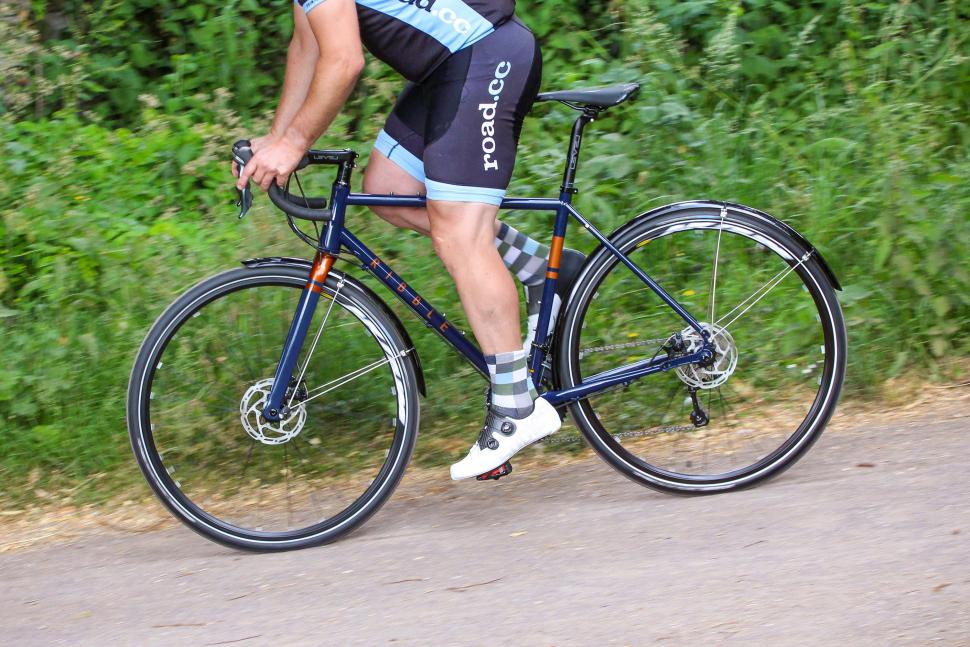
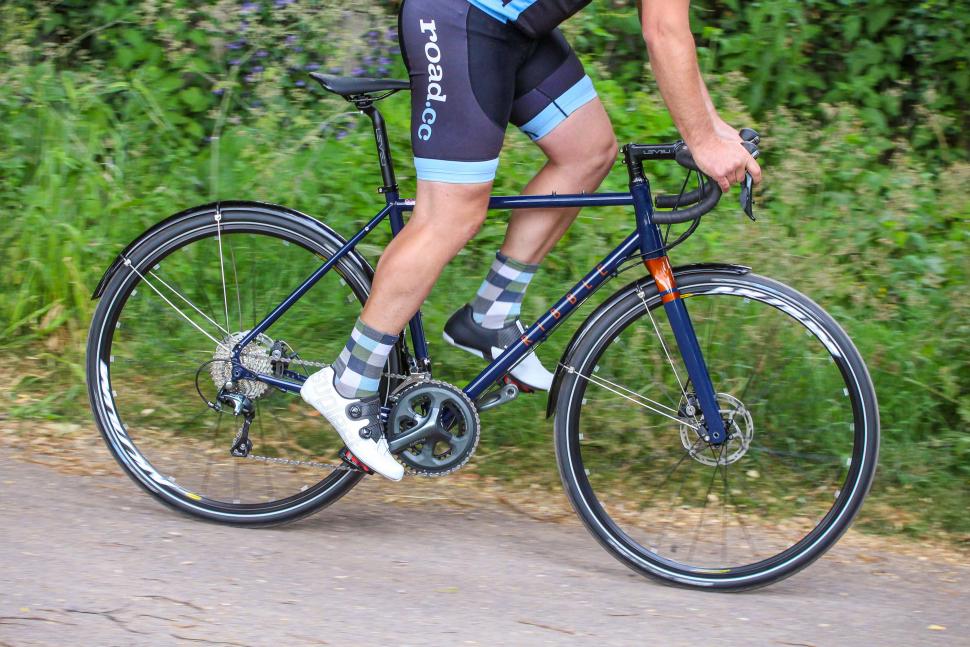

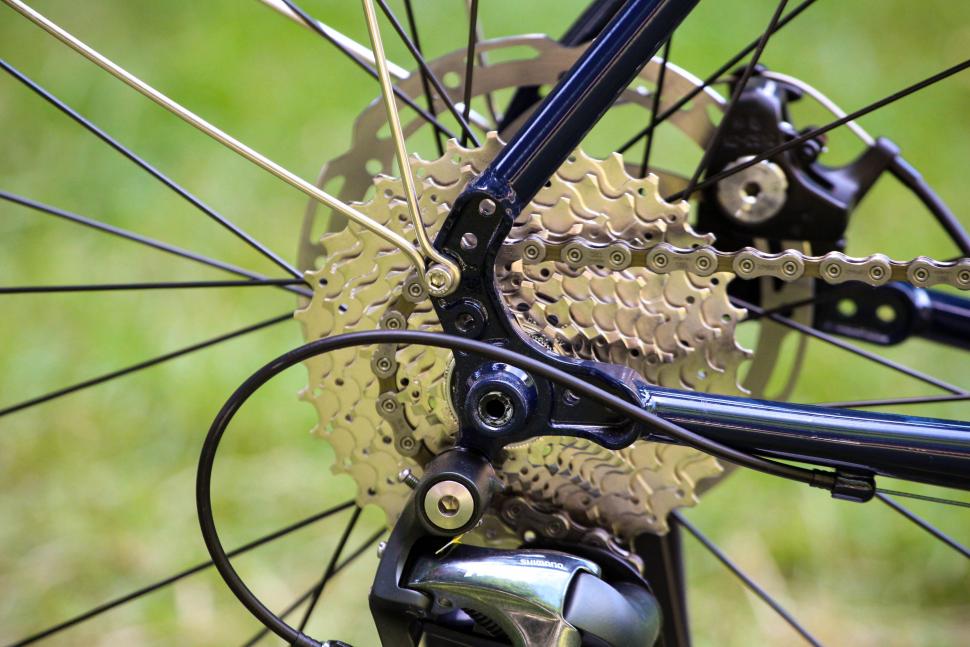


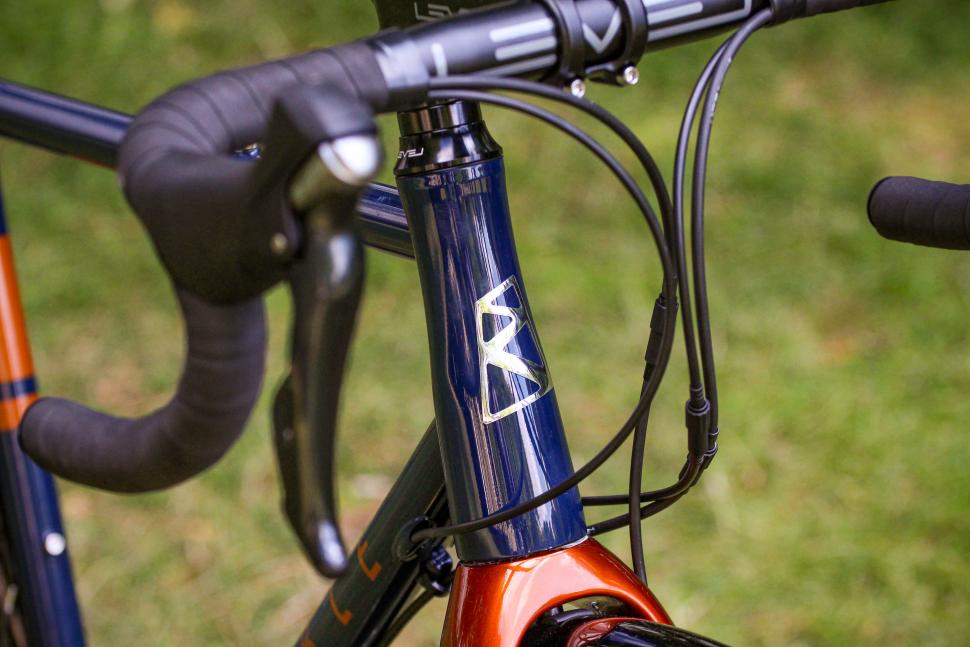



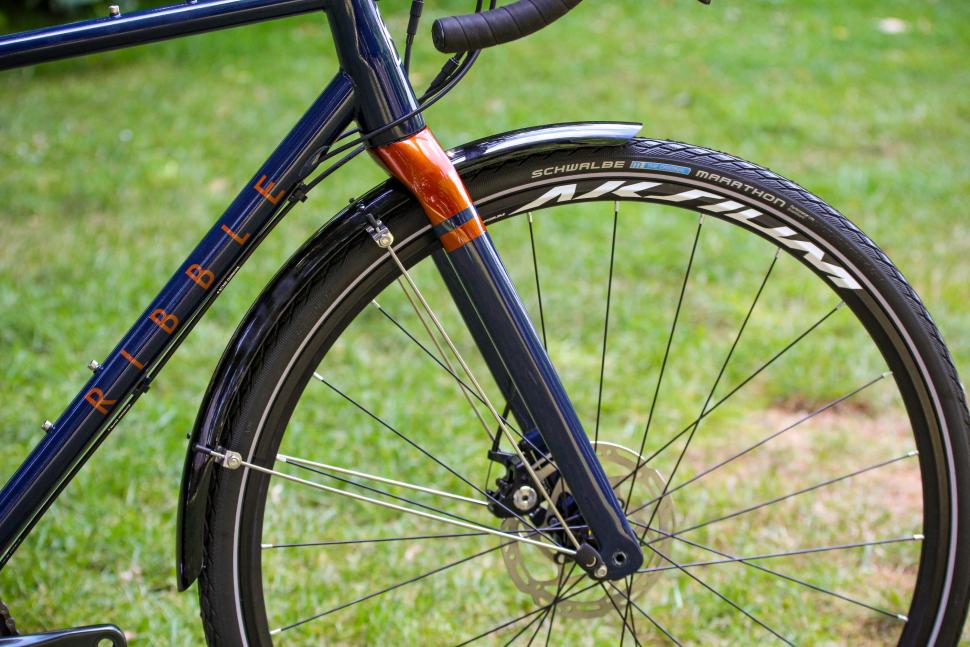
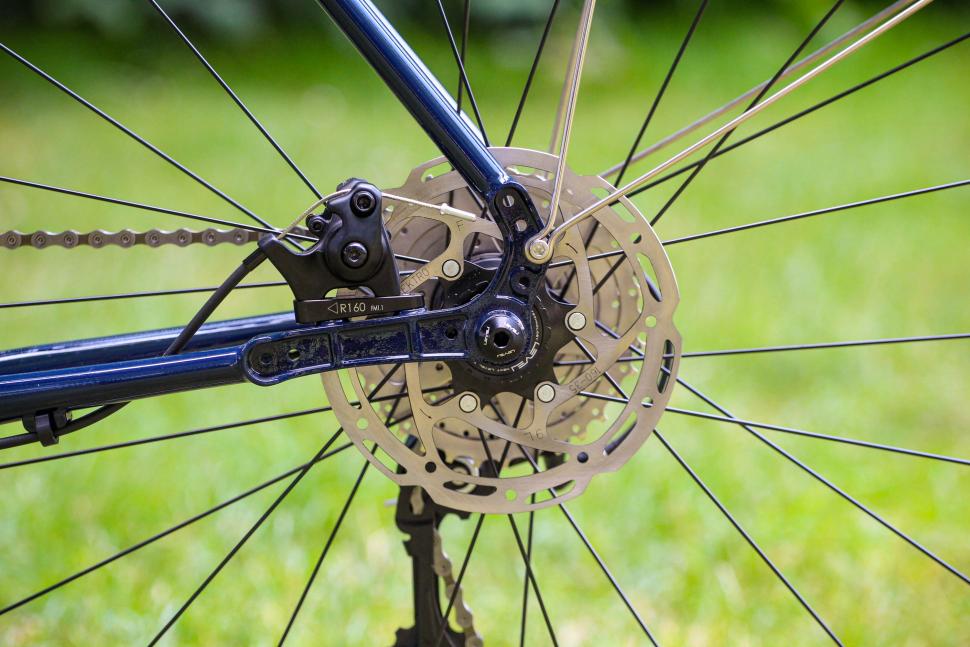
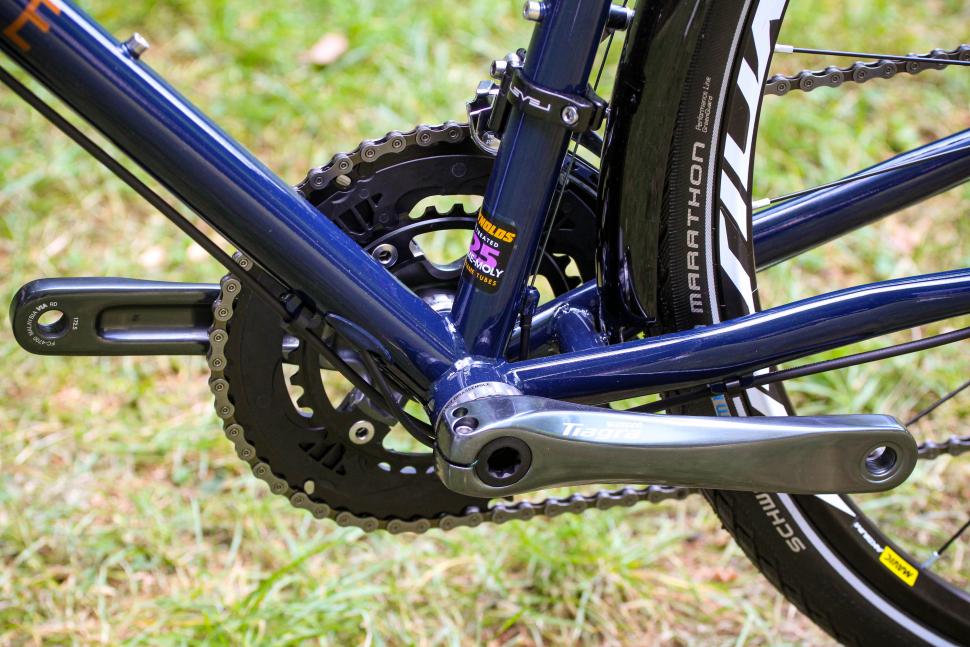
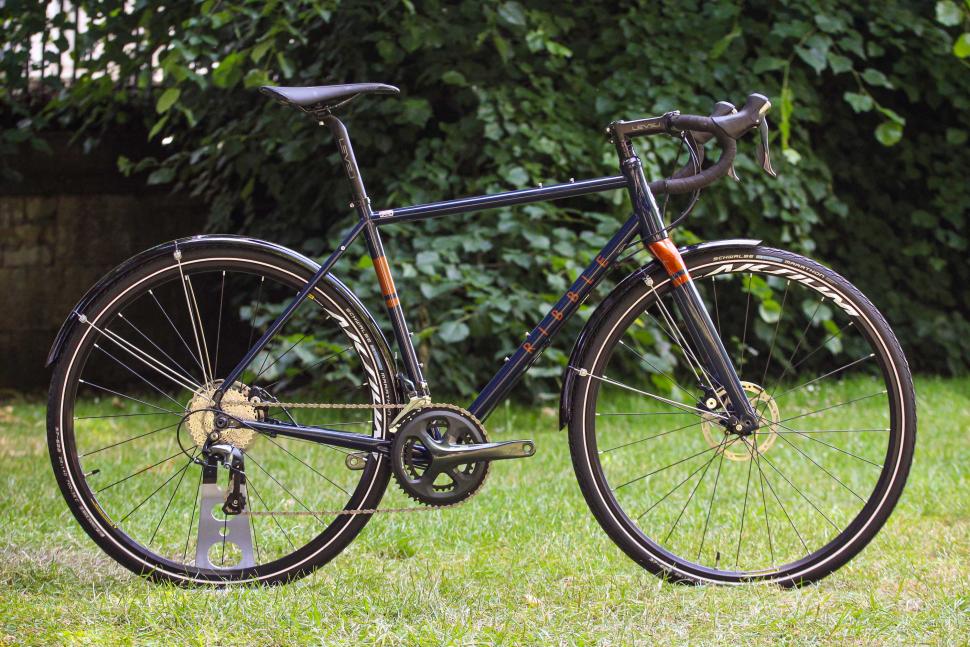
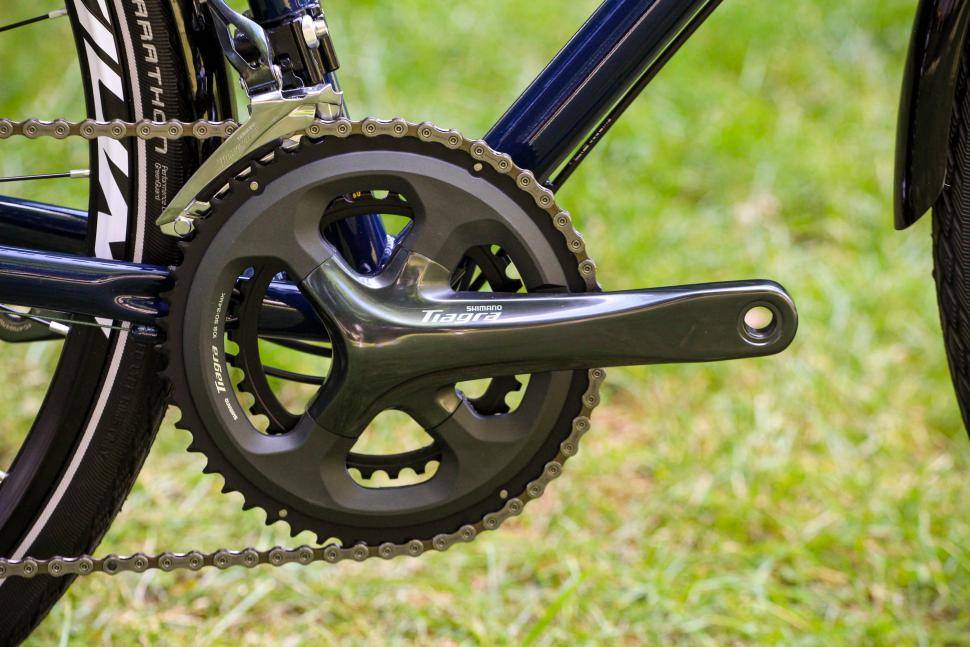
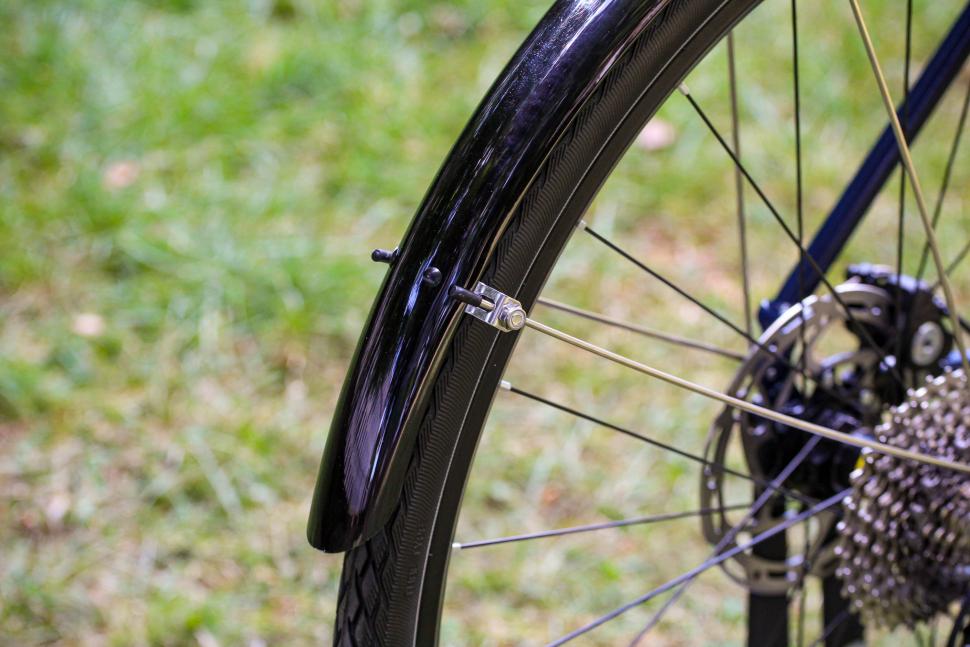


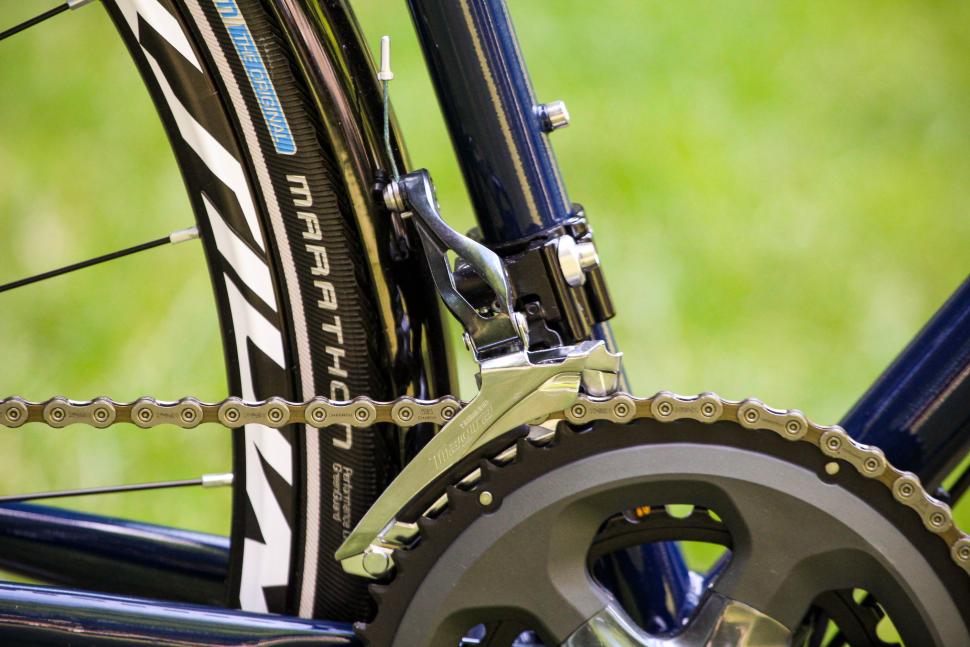








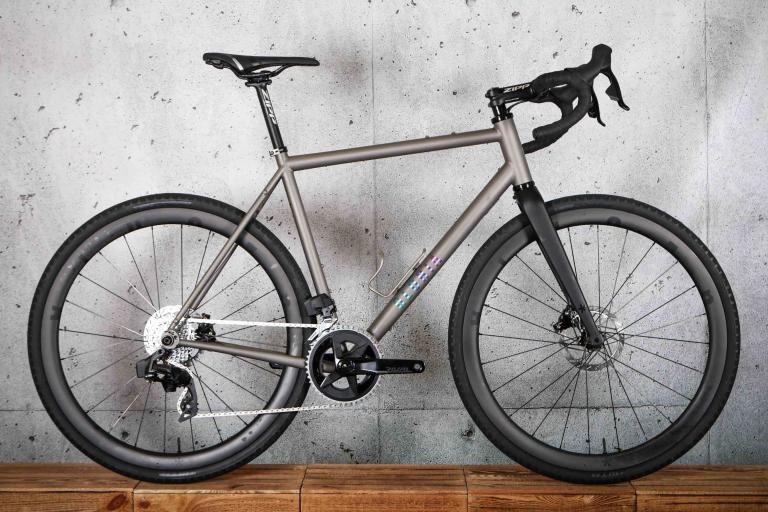
Add new comment
7 comments
Quite tempted by one of these. I've been deciding what build to go for; a week or so ago the GRX 2x10 was available, which would be ideal; then when I looked a few days later it had gone; only 1xGRX or Sram 1x are now available - and I don't want a 2x road groupset. And now the bikes won't be available until late October.
Urrgh. Cable discs on a £1300 bike is criminal imo. Think I'd take the Apex build and risk spinning out.
I have the Apex build with 700c wheels and the G-one allroad tyres, I went for the 42 front chainring instead of the 40, and for riding on the road it's fine, it's not like it's a race bike, by the time you're at the point of spinning out you might as well just freewheel down the hill. Much nicer having the hydraulic discs.
As the reviewer says, it's a lovely frame, with nice paint and some modern detailing. It is, however, let down by the rear left drop-out, which is conveniently hidden in most publicity photos, and is quite possibly the ugliest I've ever seen. It was presumably welded together with girders in order to make room for the disc calliper and does no credit to an £800 frame. But it has sort of grown on me and I don't let it spoil the overall appeal.
Ribble's size guide pointed me towards the 'small', even though I've been 'medium' for everything for the last fifty years, but it fits perfectly. It has proven to be comfortable and predictable and, the mark of a good design, it descends surprisingly swiftly.
I built up my frame using 105, Hunt wheels and lovely Hutchinson tubeless tyres. Completed by some of Mr Wiggle's finishing kit it weighs a tiny fraction over 10kg including pedals and bottle cage, so a lighter bike is well within reach if you're prepared to do some of the work.
I would buy it again.
Yep the drop out is a little agricultural, seems to do the trick though, and for what I use mine for it kind of fits the bill.
Every time I ride it I remember why I like it so much, it's just good all round.
I think it's the move to the flat mount standard that's led to those agricultural dropouts. Fairlight solved it by machining the brake mount seperately - see https://fairlightcycles.com/wp-content/uploads/2017/11/FAIRLIGHT-2018-St...
From the outside you just get a nice clean classic dropout, with a little bit of stainless bling for good measure, with all the heavy duty stuff concealed on the inside of the dropout.
I don't mind that dropout at all actually. It's a steel bike after all, and the ridges across it sort of remind me of proper Victorian wrought-iron engineering, like bridges and steam engines - and if there's one part of a bike I'd like to be slightly over-engineered, it's the bit where the brakes attach...